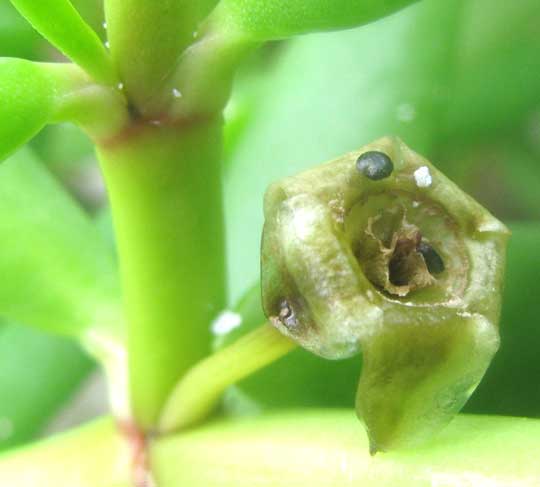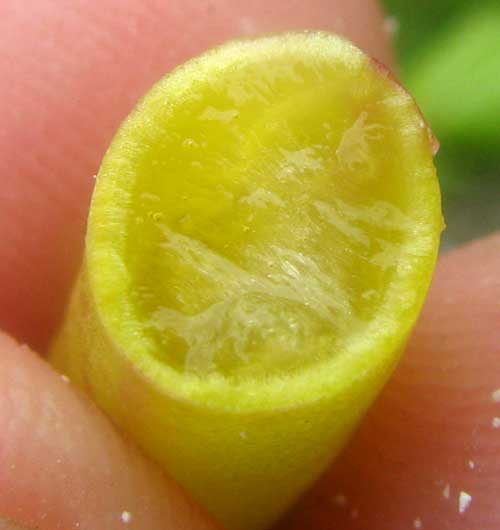Excerpts from Jim Conrad's
Naturalist Newsletter

from the June 26, 2011 Newsletter issued from Mayan Beach Garden Inn 20 kms north of Mahahual; Caribbean coastal beach and mangroves, ~N18.89°, ~W87.64°, Quintana Roo state, MÉXICO
SEA PURSLANE
All up and down the beach there's a certain sprawling perennial herb that habitually, among all the flowering plants along the beach, grows closest to the breaking waves. Clearly this plant is especially well adapted for thriving in salty sand and being coated by salt spray. The plant forms ankle-deep carpets on the sand and drapes itself over driftwood, as shown above.
Seeing the plant's succulent leaves and stems the average wildflower lover might guess that this is a Sedum, Crassula or Portulacca. However, with something like this you don't guess until you see flowers and/or fruits. That's because lots of different kinds of plants living next to the sea, through convergent evolution, develop sprawling species with short, dense, thickly succulent leaves, because that combination of features is especially adaptive for the salty seashore environment.
In fact, the plant's many-stamened flowers are unlike blossoms most of us are familiar with. For one thing, they lack petals. The things looking like white petals are "petaloid sepals." Usually sepals are green. You can see the un-petaled, many-stamened blossom below:

One of the plant's mature, already-split-open fruits is below:

A story goes with that last picture. After pollination, the fruit developed into a green, egglike capsule closely enveloped by the flower's five, green sepals. Upon maturation the sepals bent backwards (became "reflexed") and the capsule developed a fracture line around its middle, or equator -- which is very different from most splitting fruit capsules, which split lengthwise. When the capsule's top came off, black seeds were exposed lying in the capsule bottom, looking like little black eggs in a bowl. When raindrops hit inside the bowl, the water's force splashed the seeds out of the cup, dispersing them. In the last picture you can see one black seed still perched on the bowl's rim.
So, our seaside plant's main English names are Sea Purslane and Shoreline Purslane. It's SESUVIUM PORTULACASTRUM, and it's a member of the Aizoaceae, sometimes known as the Fig-Marigold Family. As that family is defined now, about 96% of its ±2500 species in 130 genera are endemic to arid or semi-arid parts of southern Africa. That explains why in the Americas we're not too familiar with the family, unless we snoop around garden centers looking at tags. Plants in the family often are sold commercially because of their pretty flowers and/or groundcover value.
Our Sea Purslane, however, is one of those rare species in the mainly African family that's native to mostly coastal, tropical and subtropical zones nearly worldwide. In the US it's found along the Gulf of Mexico and as far north on the East Coast to North Carolina.
I've never known a plant whose leaves and stems are more edible than Sea Purslane's. You can simply plop down beside a plant, pull off handfuls of succulent leaves and eat them raw without further ado. There's no hint of stringiness or bitterness, though to my taste they're a little too salty, even when washed. I think a salad of two-thirds lettuce, chopped cucumber and tomatoes, one-third Sea Purslane leaves, a bit of garlic, and doused with vinegar and oil, would make a memorable hermit salad.
You can see the succulent, crunchy interior of a leaf below:
